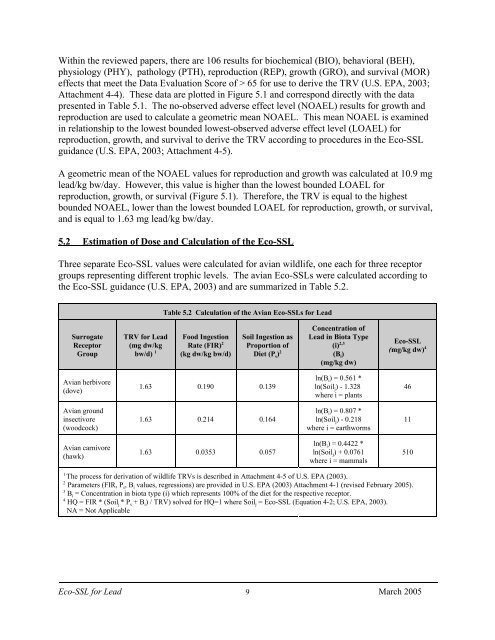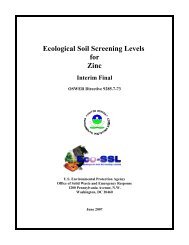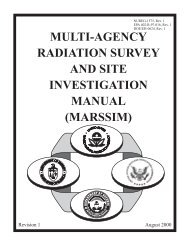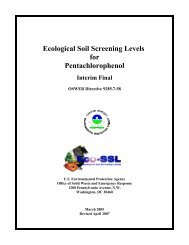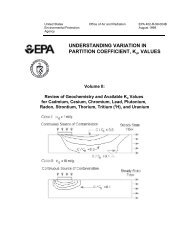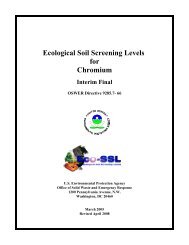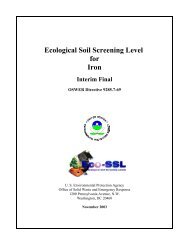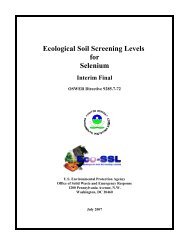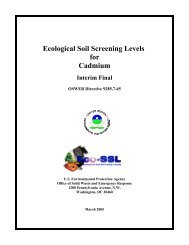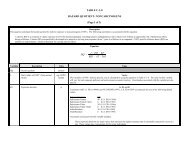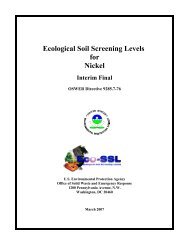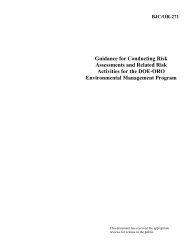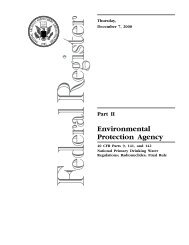C:\Eco-SSLs\Contaminant Specific Documents\Lead\November ...
C:\Eco-SSLs\Contaminant Specific Documents\Lead\November ...
C:\Eco-SSLs\Contaminant Specific Documents\Lead\November ...
Create successful ePaper yourself
Turn your PDF publications into a flip-book with our unique Google optimized e-Paper software.
Within the reviewed papers, there are 106 results for biochemical (BIO), behavioral (BEH),<br />
physiology (PHY), pathology (PTH), reproduction (REP), growth (GRO), and survival (MOR)<br />
effects that meet the Data Evaluation Score of > 65 for use to derive the TRV (U.S. EPA, 2003;<br />
Attachment 4-4). These data are plotted in Figure 5.1 and correspond directly with the data<br />
presented in Table 5.1. The no-observed adverse effect level (NOAEL) results for growth and<br />
reproduction are used to calculate a geometric mean NOAEL. This mean NOAEL is examined<br />
in relationship to the lowest bounded lowest-observed adverse effect level (LOAEL) for<br />
reproduction, growth, and survival to derive the TRV according to procedures in the Eco-SSL<br />
guidance (U.S. EPA, 2003; Attachment 4-5).<br />
A geometric mean of the NOAEL values for reproduction and growth was calculated at 10.9 mg<br />
lead/kg bw/day. However, this value is higher than the lowest bounded LOAEL for<br />
reproduction, growth, or survival (Figure 5.1). Therefore, the TRV is equal to the highest<br />
bounded NOAEL, lower than the lowest bounded LOAEL for reproduction, growth, or survival,<br />
and is equal to 1.63 mg lead/kg bw/day.<br />
5.2 Estimation of Dose and Calculation of the Eco-SSL<br />
Three separate Eco-SSL values were calculated for avian wildlife, one each for three receptor<br />
groups representing different trophic levels. The avian Eco-SSLs were calculated according to<br />
the Eco-SSL guidance (U.S. EPA, 2003) and are summarized in Table 5.2.<br />
Surrogate<br />
Receptor<br />
Group<br />
Avian herbivore<br />
(dove)<br />
Avian ground<br />
insectivore<br />
(woodcock)<br />
Avian carnivore<br />
(hawk)<br />
TRV for Lead<br />
(mg dw/kg<br />
bw/d) 1<br />
Table 5.2 Calculation of the Avian Eco-SSLs for Lead<br />
Food Ingestion<br />
Rate (FIR) 2<br />
(kg dw/kg bw/d)<br />
Soil Ingestion as<br />
Proportion of<br />
Diet (P s) 2<br />
1.63 0.190 0.139<br />
1.63 0.214 0.164<br />
1.63 0.0353 0.057<br />
Concentration of<br />
Lead in Biota Type<br />
(i) 2,3<br />
(B i)<br />
(mg/kg dw)<br />
ln(B i) = 0.561 *<br />
ln(Soil j) - 1.328<br />
where i = plants<br />
ln(B i) = 0.807 *<br />
ln(Soil j) - 0.218<br />
where i = earthworms<br />
ln(B i) = 0.4422 *<br />
ln(Soil j) + 0.0761<br />
where i = mammals<br />
Eco-SSL<br />
(mg/kg dw) 4<br />
1 The process for derivation of wildlife TRVs is described in Attachment 4-5 of U.S. EPA (2003).<br />
2 Parameters (FIR, Ps, Bi values, regressions) are provided in U.S. EPA (2003) Attachment 4-1 (revised February 2005).<br />
3<br />
Bi = Concentration in biota type (i) which represents 100% of the diet for the respective receptor.<br />
4<br />
HQ = FIR * (Soilj * Ps + Bi) / TRV) solved for HQ=1 where Soilj = Eco-SSL (Equation 4-2; U.S. EPA, 2003).<br />
NA = Not Applicable<br />
Eco-SSL for Lead 9<br />
March 2005<br />
46<br />
11<br />
510


